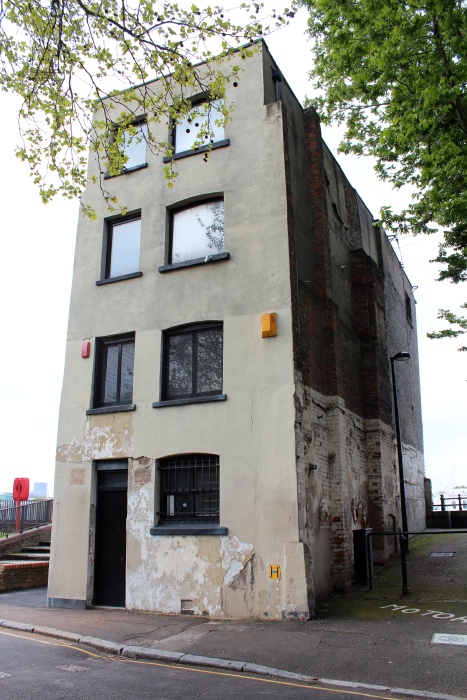It stands in supreme isolation, alone along this little stretch of the river, like a mouth with but a single tooth. How many travellers along the Thames must have wondered about this funny, narrow little building in Rotherhithe? In fact, the Leaning Tower of Rotherhithe – as it is apparently known locally – was one of several buildings in the area owned by Braithwaite & Dean, a barge company. They were a lighterage firm – lighters being flat-bottomed barges – and their lightermen moved goods between ships and quays (not to be confused with watermen, who carried passengers). This building was their office – and already tilting back in those days – where lightermen would pull up in their boats to collect their wages.
Once this whole stretch of the riverside was covered with buildings, mostly related to shipping, with a few public houses thrown in for good measure. You can see a Museum of London photograph of the area (commissioned by the Port of London Authority as part of their ten-mile panoramic documentation of the river) from 1937 here. The buildings to the west of our leaning tower were purchased in 1939 by Bermondsey Council, who planned to demolish them to build a garden. The Blitz then finished off any work that they had begun to this end.
To the east of the building stood what has been described as ‘a once absurdly picturesque row of largely wooden tenements…seedy in the extreme but vibrantly populated in the 1950s by a bohemian set of artists and writers’. Lord Snowdon lived along this row in a former coal store and is said to have met with Princess Margaret here, as well as hosting celebrities such as Marlene Dietrich and Noel Coward (who entertained him on the piano in his studio flat). In around 1960 he lent his room to John Betjeman (as you do) when his house burnt down.
Betjeman described his time here as ‘the most restful few months I had ever spent in London’, during which he enjoyed the ‘tremendous view’, including that of ‘the wharves and Georgian brick buildings of Wapping’ across the way. He moved the bed to the river-side of the room, going ‘to sleep to the solacing sounds of water’. At low tide he would listen to the sound of the waves rippling over the pebbles below, and described how at high tide ‘after a tug had passed the water made a plopping sound right against my bedroom wall as thought I were in a ship’s hold’. Until the Thames Barrier was built this whole area was of course subject to the risk of flooding; Braithwaite & Dean’s offices were flooded in 1953.
Despite a campaign by both Betjeman and Snowdon, the rather romantic-sounding row of buildings to the east was also pulled down by the local council after being condemned as a health hazard during the 1960s. It’s not known exactly why this particular structure was allowed to remain. It is not of any particular architectural value, though perhaps it was its brickwork that saved it, as many of the other buildings were wooden so arguably less sound structures. The King’s Stairs Gardens were then created here, and contain the remains of what is thought to be King Edward III’s manor house, circa 1353, uncovered by a Museum of London dig in the 1980s. Braithwaite & Dean stayed on in the leaning tower until the early 1990s, and it is now a (very) private residence.
The house is located at the very end of Fulford Street (you can’t miss it!), roughly equidistant between Bermondsey tube station and Rotherhithe overground station. The photograph taken from across the river was shot (with a zoom lens) from Wapping’s Waterside Gardens.







